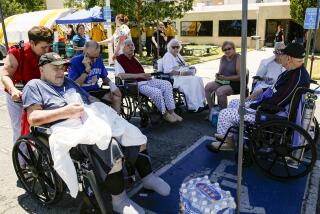Major Cuts in County Health Care Foreseen
- Share via
Los Angeles County health officials will recommend “draconian” cuts next month, possibly including thousands of job cuts and conversion of two of its six public hospitals into clinics, officials said Wednesday.
The proposals are intended to narrow a budget deficit that is expected to reach $688 million in three years. Though the details are in flux, officials are considering proposals to convert High Desert Hospital in the Antelope Valley and possibly one more hospital into outpatient facilities. Another option is moving Rancho Los Amigos Medical Center, a rehabilitation center in Downey, out from under the county Department of Health Services so that it would become self-supporting. Cutbacks at other hospitals are likely.
Dr. Thomas Garthwaite, director of the health services department, said Wednesday that several thousand jobs would be cut if the county cannot get more federal money.
“I don’t see any way around it unless there were a massive infusion of funds,” he said. “The money’s got to come from somewhere.”
Supervisor Zev Yaroslavsky said the cuts are likely to be “draconian.”
“Everyone who has a stake in this health system is going to get their toes stepped on,” he told a group of health-care professionals Wednesday, “so get your Dr. Scholl’s. It’s not going to be without pain.”
Dwindling federal assistance means that the health department will run a $360-million deficit by next year. Supervisors plan to fly to Washington next week to urge the Bush administration to give them access to more money, but they are not optimistic.
After the supervisors return, Garthwaite is scheduled to present them with a proposal for cuts to close the deficit. The reductions could be approved by October.
A political storm is brewing. “We believe that the public is not going to sit by idly while this health system is dismantled,” said Bart Diener, assistant general manager of Service Employees International Union Local 660, the union that represents most of the health department’s 22,000 workers.
Diener acknowledged that Garthwaite needs to plan for dire cuts, but said supervisors should focus on finding new money to keep the system afloat. “There’s too much of an effort to say they’re tough enough to make the cuts and not enough courage to demand what the patients require,” he said.
Melinda Paras, the former president of Alameda County’s public health authority and now the executive director of the consumer group Health Access, said her organization will fight closure of any hospital.
“Removing that last resort for the delivery of health care, I find really frightening,” she said.
Kathryn Barger, the chief of staff for Supervisor Mike Antonovich, whose district includes High Desert Hospital, said the supervisor was not flatly opposed to cuts there. But she warned that any reductions must be accompanied by plans to ensure that residents of the remote Antelope Valley have access to health care.
“We have to make sure it’s not compromising the quality ... of care,” she said.
After Garthwaite’s predecessor, Mark Finucane, proposed closing High Desert last year, Antonovich publicly scolded him for not recommending anything to fill the void. Not long afterward, the supervisors pushed Finucane out of his job.
But in December, already facing a massive deficit, supervisors voted to study building an emergency room in High Desert Hospital and expanding the emergency room at Harbor-UCLA Medical Center, another hospital that may be downsized.
Los Angeles County’s health department has been financially teetering for a decade, largely because the region is home to nearly 3 million uninsured people who rely heavily on county facilities. Making matters worse, federal and state governments have steadily pared funding for public hospitals.
County supervisors have hesitated to substantially cut health services. The county went to the brink of bankruptcy in 1995 before securing a $1-billion bailout from the Clinton administration. The White House renewed that bailout in 2000, but the amount of money coming to Los Angeles decreases each year until 2005, when it vanishes.
After each bailout, supervisors vowed to make deep cuts but made only relatively small trims. They often blamed weak managers and union pressure. But supervisors were reluctant to cut medical services in their own districts--especially politically popular but costly hospitals.
After securing the latest bailout in June 2000, supervisors pledged to avoid the hasty, scrambled budget-cutting that led to thousands of abrupt layoffs in 1995. But it was not until January of this year that they made their first trims, saving about $13.5 million through internal restructuring and closing five clinics--one in each supervisor’s district. All other cuts were deferred until Garthwaite, hired in December from the Veterans Administration in Washington, arrived.
Whatever the financial picture, some officials, including Antonovich and Garthwaite, believe that the health department needs major restructuring. “There are things that need to be done whether we get a bailout or not,” said Antonovich chief of staff Barger.
Garthwaite said the six county hospitals are not linked to a common computer network and many offer services that could be centralized. Critics attribute that to the supervisors treating each hospital as their own turf rather than as part of a countywide network.
Health experts said the supervisors must put politics aside in planning the cuts.
“If political issues drive these decisions, it will potentially have a detrimental effect on the health-care fabric of the entire area,” said Dr. Michael Karpf, vice provost for hospital systems at UCLA.
“If it’s the best medical decisions, we’ll just have to learn how to live with them and adapt,” he said.
Jim Lott, executive vice president of the Hospital Assn. of Southern California, said the loss of any county-operated hospitals would be devastating.
The county hospitals now provide 50% of the emergency-room care in the county, he said.
Any loss would have to be made up by private hospitals, which already divert ambulances regularly because of overcrowded emergency rooms.
“It will begin to have a domino effect throughout the system,” Lott said. “Ambulances will be scrambling more and more.”
But Lott said private hospitals realize that there really isn’t any choice given the dramatic deficit.
“The only thing that can prevent this is an infusion of dollars, and we can’t see where it’s coming from,” he said.
“We certainly don’t see the state with its current financial problems being able to do anything for the county, and we don’t believe that the federal government will come to the rescue a third time,” he said.
More to Read
Sign up for Essential California
The most important California stories and recommendations in your inbox every morning.
You may occasionally receive promotional content from the Los Angeles Times.










